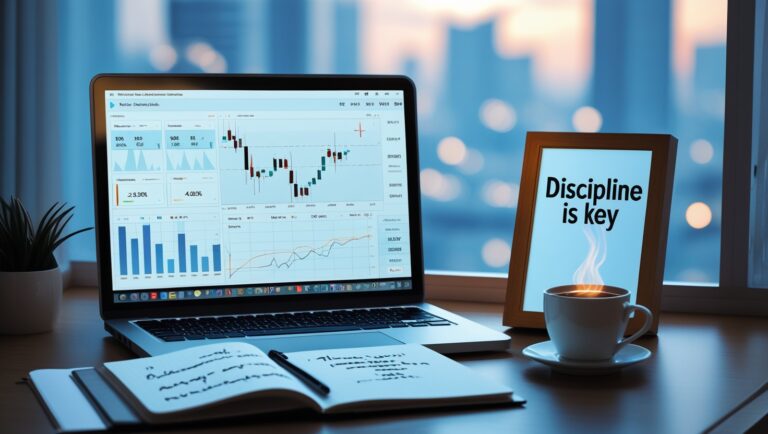Stock Market Basics: How to Buy Your First Shares
Stock Market Basics: How to Buy Your First Shares
When I first started learning about the stock market, I felt completely lost. I didn’t know where to begin, which platform to use, or even how much money I needed to start. If you’re a beginner, I want you to know that buying your first shares is simpler than it seems.
In this guide, I’ll explain stock market basics, the tools I personally use, and how I turned my stock account into a system that helps me pay bills and grow wealth.

Table of Contents
Step 1: Choose a Beginner-Friendly Platform
The first step is selecting a platform that’s easy for beginners. I started with Robinhood because it’s intuitive and commission-free. This allowed me to make my first purchase without stress.
Sign up for Robinhood here 👉 Robinhood Free Stock
I also use Webull, which is still beginner-friendly but provides advanced charting tools and research options that helped me make smarter decisions.
Get your free stock on Webull here 👉 Webull Free Stock
Step 2: Fund Your Account
You don’t need a huge amount to start. I personally began with $100, which was enough to learn the process of buying, selling, and monitoring stocks without feeling overwhelmed.
Step 3: Decide What to Buy
As a beginner, it’s important to choose stocks you understand and are familiar with. Avoid buying trending stocks or following hype. Focus on companies you know and can research easily.
Step 4: Use Tools to Analyze Stocks
I quickly realized that using TradingView made stock analysis much easier. With it, I could read charts, spot trends, and understand basic patterns even as a beginner.
Start exploring TradingView here 👉 TradingView Charts
Even basic chart reading can make a big difference in understanding when to buy and sell.
Step 5: Make Your First Purchase
Buying your first shares is an exciting milestone. Start small, track your investments, and learn from the process. Every trade builds your confidence and understanding of the market.
Step 6: Monitor Your Investments
After your first purchase, it’s important to monitor your stocks without obsessing over every price change. I check my accounts once or twice a day to stay informed while focusing on long-term growth.
Step 7: Build a System
One of the most important things I learned is creating a system for consistent growth. I take a small percentage each month from my stock account to pay bills and groceries while leaving the rest to grow.
I explain this fully in my ebook 👉 How I Pay My Bills with Stocks
Step 8: Keep Learning
Even as a beginner, you can continuously improve your skills. Each trade teaches something new, and using tools like Robinhood, Webull, and TradingView makes the learning process faster and easier.
Final Thoughts
Buying your first shares doesn’t have to be complicated. By choosing the right platform, starting small, using charting tools, and following a consistent system, you can confidently enter the stock market.
✅ Start with Robinhood here: Robinhood Link
✅ Grab a free stock on Webull here: Webull Link
✅ Learn my full system in my ebook: Pay Bills with Stocks
One of the first lessons I learned as a beginner is that you don’t need a large budget to start buying stocks. Even $50 or $100 is enough to learn the basics and gain confidence.
I started with Robinhood sign up here because the platform is simple, intuitive, and commission-free. This made my first trades stress-free.
Later, I added Webull get your free stock here for access to advanced charting tools and research options, which helped me analyze stocks more effectively.
I also use TradingView start here to read charts and spot trends. Even beginners can quickly understand basic patterns with a little practice.
Starting small and being consistent is more important than investing large sums immediately. Regular small investments helped me gain confidence and steadily grow my portfolio.
I keep a journal of why I buy each stock. Writing down my reasoning helps me stick to a plan and avoid making emotional decisions during market fluctuations.
Diversifying your investments is key. I make sure not to put all my money in one stock. Spreading it across a few companies reduces risk while still allowing for growth.
I treat my stock account like a paycheck. Every month, I withdraw a small percentage to pay bills and groceries, while leaving the rest invested to grow. This system is explained fully in my ebook 👉 How I Pay My Bills with Stocks.
Avoid following hype or trending stocks on social media. I learned that it’s safer and more effective to focus on researched, reliable companies.
Setting a trading routine has been a game-changer. I check my accounts once or twice a day, instead of constantly refreshing charts, which keeps me focused and calm.
You don’t need a degree in finance to start. Patience, discipline, and beginner-friendly tools like Robinhood, Webull, and TradingView are enough to succeed.
Even small mistakes can teach huge lessons. I once bought a stock too early and lost a little money, but it helped me understand chart reading and entry timing better.
Taking action is better than waiting for the “perfect moment.” Open your account, fund it, and make that first trade—you’ll learn faster by doing than by endlessly researching.
Learning while doing is the key. Every trade, chart review, and platform you try builds confidence and knowledge, making the stock market manageable instead of intimidating.
Finally, remember that starting with small steps builds long-term growth. By learning, investing consistently, and using the right tools, even beginners can turn small investments into meaningful results.
✅ Start with Robinhood here: Robinhood Link
✅ Grab a free stock on Webull here: Webull Link
✅ Learn my full system in my ebook: Pay Bills with Stocks

Stay ahead in the stock market! Subscribe to our newsletter and receive exclusive stock flow reports, trading insights, and actionable tips directly in your inbox. Join thousands of traders who get our updates first.







